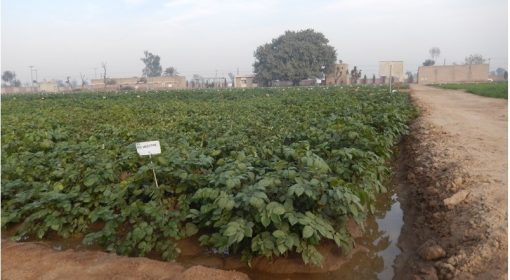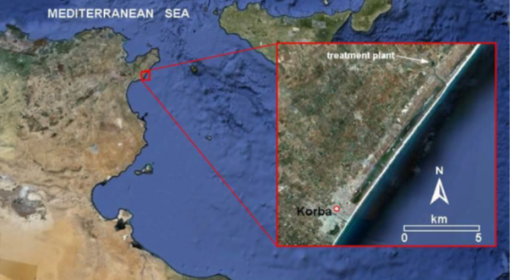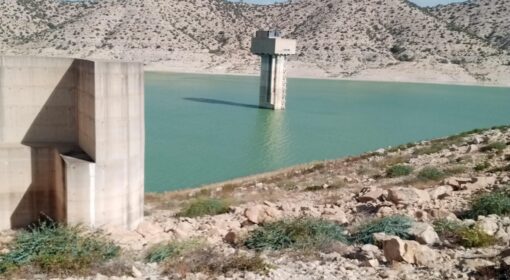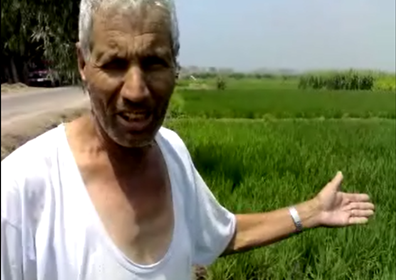By Ashraf Ghanem

Water saving in irrigation is of paramount importance as agriculture is the prime water user in water scarce countries. Drip irrigation is known as one of the most water-efficient water application methods and is rolled out in a major way. Nevertheless, it comes with a cost, and it is not always delivering the goods. I will try to provide a simple evaluation and highlight some potential environmental impacts with regards to its potential implementation for sugarcane cultivation in Upper Egypt, a major and high water demanding crop, where drip irrigation is heavily promoted.
1. Limited degree of water saving
Drip irrigation minimizes water losses from the soil and from percolation to deeper layers. The question is, how relevant this is in the context of sugarcane cultivation in Upper Egypt.
Sugarcane is a crop which has a dense canopy. A few weeks after initial transplant or after harvest and re-emergence of new shootlings, the canopy covers almost all of the ground. Hence evaporation from the soil is minimized and this potential benefit from drip irrigation is then no longer significant. Water is either lost as transpiration from the plants (which is necessary for plant health and growth) or deep percolation. The amount of water for crop transpiration (high in case of sugarcane) has to be supplied, be it using drip or surface irrigation. The difference is that with surface irrigation some water may seep into the ground below the root zone. In the desert lands of Egypt, infiltration might be considerable and therefore modern irrigation is mandatory. Yet in the fertile lands of the Nile Valley and Nile Delta the picture is different as they are underlain by a relatively thick clay layer of several meter thickness, which limits such deep infiltration to a great extent. In fact, the water that seeps into the ground from ‘inefficient’ irrigation is not at all lost in the Nile Valley in Upper Egypt. Water percolating into the ground is either intercepted by the subsurface drainage system, from where it is reused through directing the water back to the fresh water sources (drainage water reuse), or percolates deeper into the ground to feed the shallow Nile Aquifer, which is a highly productive aquifer underlying the fertile lands along the course of the Nile. Drainage water reuse is an integral part of Egypt’s water balance supplying more than 16% of the total water demands.
2. Impact on the Nile Aquifer
The Nile Aquifer in Upper Egypt is an important source of fresh water for the population around the Nile River. It represents a vital source of drinking for villages in the Nile Valley, particularly at remote locations. The water is usually of high quality with little or no need for further treatment. The Aquifer supplies 50%, 42% and 8% of the drinking water in Asyut, Suhag, and Quena Governorates, respectively (CAPMAS, 2017). Average annual rainfall in Upper Egypt is practically 0.0. Thus the only source of recharge for this strategic aquifer is water from the surface irrigation system (canals, drains, and surplus irrigation from farmlands). Some of the water applied on the agricultural lands seeps into the ground and recharges the aquifer. Therefore, groundwater flow in Upper Egypt is generally towards the Nile River, which acts as a large drain (Figure 2).
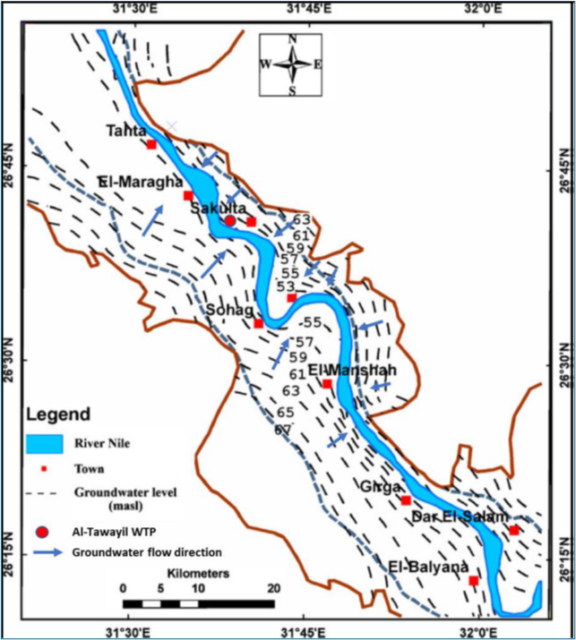
Further, the aquifer represents a strategic reserve for any emergency situation which might arise if the water levels in the Nile become too low for the drinking water treatment plants’ intakes along the Nile River.
Lining the canals during the past years has already limited recharge to the aquifer. Changing considerable areas of farms from surface to drip irrigation in these governorates will severely decrease recharge, which will inevitably have a negative impact on the water quantity and quality of the aquifer.
3. Salinity considerations
Some 55.5 billion m3 of water enter Egypt every year through its southern border. At an average salinity of 200 ppm in the Aswan Dam Lake, this water also brings in about 11 million tons of salt every year. If this salt is not flushed out, it will accumulate in the system and lead to soil salinization. Surface irrigation together with a well-designed and functional drainage system has aided in keeping the soil along the Nile in excellent condition over the years. Drip irrigation creates a low-salinity zone around the plant roots and pushes the salts out into the adjacent soil leading to high salinity zones in between plant rows. Salinity will continue to increase unless flushed using fresh water. Soil salinities in excess of 20,000 ppm have been often observed in between rows of drip irrigated orchards in Egypt. Flushing is challenging and requires a considerable amount of fresh water, negating the hoped-for water savings. If, after several years of cultivation, the land needs to be recultivated, ploughing of the land will mix the salts within the top layer, creating a soil which is much less suitable for cultivation than in the original state.
In countries like India and Brazil, where drip irrigation is sometimes implemented for sugarcane cultivation, irrigation is usually only used for supplemental water supply during dry seasons. Nevertheless, there are periods with abundant rainfall (which has a near zero salinity and is hence an excellent solvent), which periodically flushes away any accumulated salts. So, what might be suitable in a certain setting might be less suitable under the extreme dry conditions of Upper Egypt.
4. Questioning a monoculture crop
Breaking up the sugarcane monoculture by growing other crops in rotation with sugarcane has proven to be beneficial to the environment and productivity. Many farmers practice subsistence farming to satisfy the needs of their households and livestock, while some farmers also choose to grow income-generating rotation crops. Having an extended area devoted solely to sugarcane production will be detrimental to soil fertility and negatively impact yield with time.
5. Hydraulic considerations
Drip irrigation in the extremely hot climate of Upper Egypt is expected to require daily water applications. If a rotation system is in place, this needs to be either changed to continuous flow, or storage needs to be provided to supply the off period. Attempts to change rotation to continuous flow were made during the past decades in Irrigation Improvement Projects with no success (IWMI 2015). On the other hand, storage tanks will need land which is expensive and might not be readily available.
6. Energy nexus and costs
The attempt to change surface to drip irrigation comes with considerable costs. While some water saving is hoped for (but expected to be limited if looked at from an overall water use efficiency as outlined in Section 1), an increase in energy requirements is certain. Drip irrigation requires first filtration at the source. Nile water is relatively turbid and carries an array of very fine sediments and microorganisms. Filtration will be challenging, in particular if pressure compensating drip lines are to be used. In addition, maintenance of the drip line or even detecting emitter blockages inside a grown sugarcane field will be another challenge. The supply of water at the right pressure to overcome hydraulic losses in the filter and in the long water supply lines and provide water at the emitter at the right pressure will require pressure of several bars. This high energy requirement is not the case in surface irrigation. Cultivating large areas using such energy intensive systems will place another heavy burden on the already stressed energy supply system of the country.
Another concern is the cost of the drip irrigation system, from the main pump stations to surge protection to the main water distribution network, to the secondary distribution network to the last emitter. To have a reliable water supply system, the cost will be expensive. Most of the components are not locally manufactured, placing an additional pressure on the already stressed economy and foreign currency reserves. Even for components which are locally manufactured such as pipelines, the raw material is imported. Further, components such as drip lines will need frequent replacement, particularly in the heat of Upper Egypt. Who will carry all these costs for full-blown implementation? And is the return justified. A thorough cost-benefit analysis needs to be conducted, but preliminary indicators are not promising.
7. Are there alternatives?
7.1Water application adapted to the existing surface water irrigation system.
There are other water application methods such as trench irrigation, which reportedly can provide considerable water saving while maintaining the (benefits of the) surface irrigation system. Savings of 18% of the applied irrigation water was reported in India (link to source under Figure 3). There would be no need for all the expensive infrastructure and energy inputs for installing a drip system as discussed above, just laser land leveling and land shaping using a regular tractor. Such equipment is readily available in any village in Egypt.
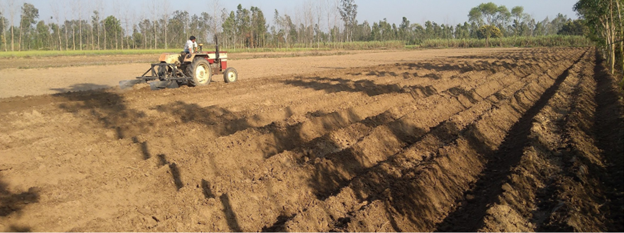
Other benefits include an increased yield of a higher quality crop and allowing for intercropping. With intercropping, water-use efficiency WUE further goes up to 34 percent, according to a WWF-India analysis (link above).
In fact, cultivation on raised beds in conjunction with the existing surface water irrigation system has been successfully piloted in Egypt in the past with little cost but considerable benefits. See for example https://repo.mel.cgiar.org/handle/20.500.11766/12208

7.2 Alternate sugar crop
Are there alternatives to sugar cane? A comparative study was conducted at Cairo University between water use efficiency of sugarcane and sugar beet cultivation under conditions of Upper Egypt (Quena and Minya Governorates, respectively) using FAO WaPOR. The following figure compares crop water productivity for sugarcane and sugar beet over six growing seasons.
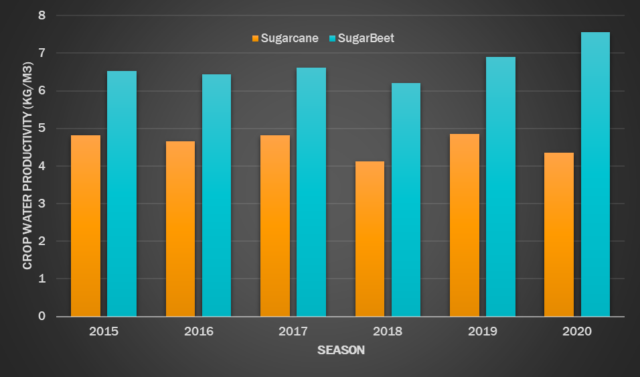
The main conclusions of the study include:
- The sugar beet growing season is only 6 months compared to 12 months for sugarcane – so less water needed.
- An advantage of sugar beet is that it is cultivated during the winter in Egypt when crop water requirements are lowest.
- Sugar beet is more tolerant to water and soil salinity than sugarcane.
- Crop water productivity of sugar beet averages 6.5 kg/m3, compared to 4.7 kg/m3 for sugarcane.
- Sugar water productivity has been calculated. Sugar beet produces 940 grams of sugar per m3 of water, compared to 470 grams/m3 for sugarcane.
Therefore, it might be worthwhile to investigate (the possibility of) changing the existing sugar factories in Upper Egypt from sugarcane to sugar beet processing.
Sugar beet water productivity could be further improved if planted on raised beds. The following figure shows a raised bed sugar beet farming trial in the Old Lands of Minya, Upper Egypt.

